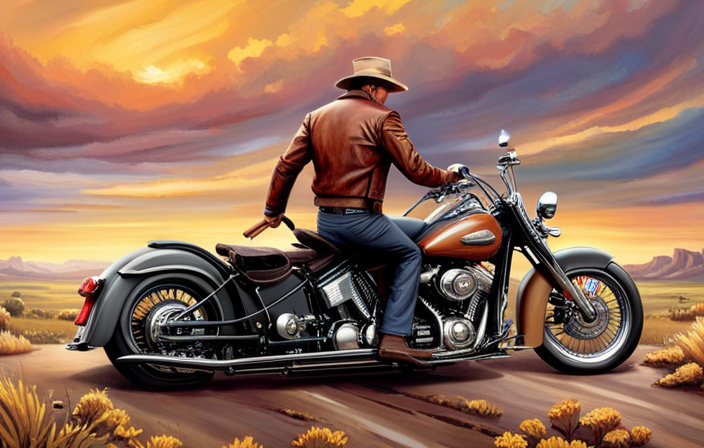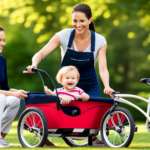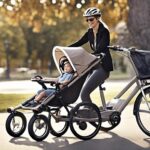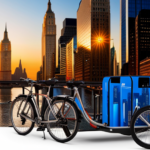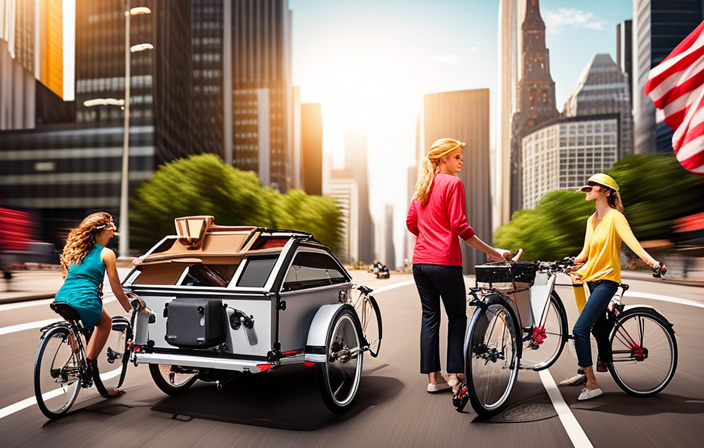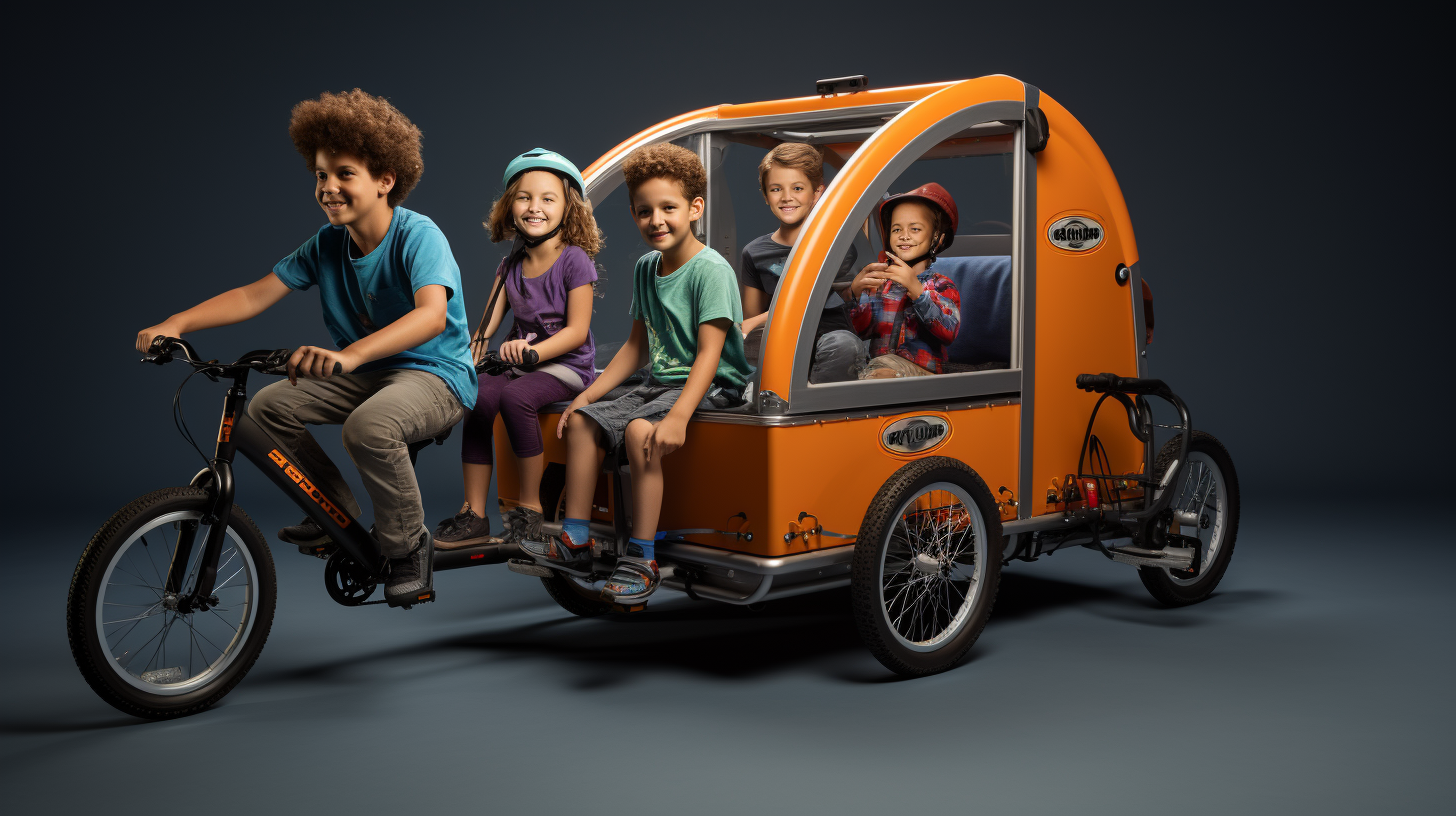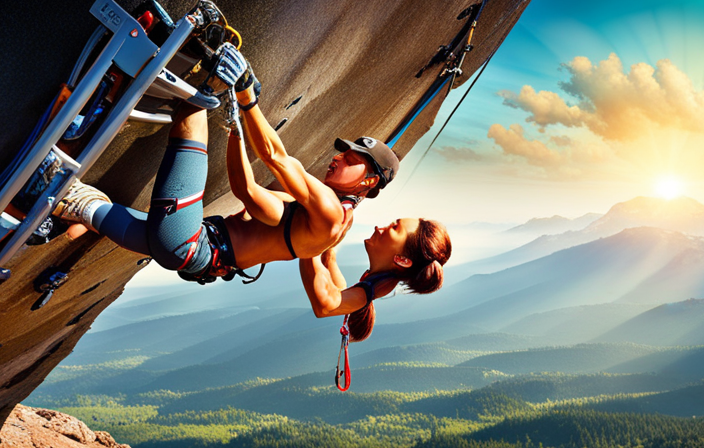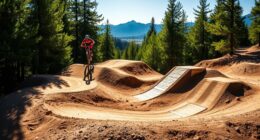As a parent, I understand the importance of finding safe and fun activities for our children. That’s why I’m thrilled to provide you with some useful information on when babies can start using bike trailers.
In this article, we’ll explore the age requirements, physical development milestones, and safety guidelines to ensure your baby’s well-being while riding in a bike trailer.
So, let’s dive in and discover the wonderful world of biking with your baby!
Key Takeaways
- Pediatricians recommend waiting until baby is at least 12 months old before using a bike trailer.
- Baby should have developed sufficient neck strength and be able to sit up independently.
- Baby’s core muscles should be strong enough to maintain proper posture in the bike trailer.
- Baby should be able to sit securely in the bike trailer without additional support and have good head and neck control while riding.
Age Requirements for Bike Trailer Use
Babies can start using bike trailers once they reach the age requirements. It is important to consider their physical development milestones and follow helmet safety guidelines.
Bike trailers are a great way to introduce your little one to the joys of cycling, but it is crucial to ensure their safety and well-being.
According to research, most pediatricians recommend waiting until your baby is at least 12 months old before using a bike trailer. At this age, they have developed sufficient neck strength to support the weight of a helmet and withstand the jostling that comes with riding in a trailer. It is also important to ensure that your baby can sit up independently without slumping over. This indicates that their core muscles are strong enough to maintain proper posture during the ride.
Additionally, always make sure your baby is wearing a properly fitted helmet that meets safety standards. The helmet should sit level on their head, snug but not too tight, with the straps securely fastened. This will protect their fragile skull in case of any accidents or sudden stops.
In the next section, we will discuss the physical development milestones for bike trailer use, which will further guide you in determining when your baby is ready to embark on their cycling adventures.
Physical Development Milestones for Bike Trailer Use
As you reach certain physical development milestones, you’ll be ready to hop on board a bike trailer. Baby bike trailer readiness is not solely determined by age, but also by motor skill development milestones. It’s important to ensure that your baby has the necessary physical abilities to safely enjoy a ride in a bike trailer. Let’s take a look at some key motor skill milestones that indicate your baby is ready for this adventure:
| Motor Skill Development Milestones | Baby Bike Trailer Readiness |
|---|---|
| Can sit up unsupported | Able to sit securely in a bike trailer without additional support |
| Has good head and neck control | Can hold their head steady while riding in a bike trailer |
| Can maintain balance | Able to sit and balance themselves without toppling over |
| Can grasp and hold on | Can hold onto the sides or handlebars of the bike trailer |
| Can follow basic instructions | Can understand and follow simple directions while in the trailer |
It’s important to note that every baby develops at their own pace, so it’s crucial to assess your individual baby’s readiness before using a bike trailer. Once your baby meets these milestones, you can proceed with confidence, knowing that they are physically capable of enjoying a ride in a bike trailer. In the next section, we will discuss guidelines for ensuring your baby’s safety in a bike trailer, so you can have peace of mind during your rides together.
Guidelines for Ensuring Baby’s Safety in a Bike Trailer
Before embarking on a ride with your little one in a bike trailer, it’s crucial to follow these guidelines to ensure their safety.
-
Assess your baby’s physical readiness: It’s important to make sure that your baby is physically capable of being in a bike trailer. Check with your pediatrician to ensure that your baby has good neck control and can sit up without support. This will help prevent any potential injuries or discomfort during the ride.
-
Proper supervision is key: Always keep a close eye on your baby while they are in the bike trailer. Make sure they are secure and comfortable, with all the safety harnesses properly fastened. Stay vigilant throughout the ride, paying attention to any signs of discomfort or distress. Remember, your baby relies on you for their safety, so never leave them unattended in the bike trailer.
-
Choose a suitable riding environment: Opt for smooth and well-maintained paths or bike lanes to minimize any bumps or sudden movements. Avoid busy roads or areas with heavy traffic. Additionally, consider the weather conditions and plan your ride accordingly. Extreme temperatures can affect your baby’s comfort and safety.
Understanding the importance of proper helmet fit is crucial to your baby’s safety.
Understanding the Importance of Proper Helmet Fit
Make sure you properly adjust and secure your little one’s helmet to ensure their safety while riding in a bike trailer. Helmet safety guidelines are crucial when it comes to protecting your child’s head from potential injuries.
The proper helmet fit is essential to maximize its effectiveness. When fitting the helmet, make sure it sits level on your child’s head, covering their forehead and not tilting backward or forward. The straps should form a V-shape under their ears, and the buckle should be securely fastened under their chin. Additionally, the helmet should not move more than an inch in any direction when you try to shift it.
It’s important to choose a helmet that meets safety standards and is specifically designed for biking. Look for helmets with labels such as CPSC or ASTM certified to ensure they meet the necessary safety requirements. Remember, a properly fitted helmet is a key element in protecting your child’s head during bike rides.
Transitioning into the introduction to bike trailer safety features, it is crucial to understand that helmets are just one aspect of ensuring your little one’s safety while riding in a bike trailer.
Introduction to Bike Trailer Safety Features
To ensure your child’s safety while riding in a bike trailer, it’s important to familiarize yourself with the various safety features available. Bike trailer maintenance and safety precautions while riding with a baby are essential to keep your little one protected on your biking adventures. Here is a table outlining some of the key safety features to look for in a bike trailer:
| Safety Feature | Description | Importance |
|---|---|---|
| Sturdy Construction | Look for a trailer made of durable materials to withstand bumps and jolts. | Provides stability and protects your baby from potential accidents. |
| 5-Point Harness | A secure harness ensures your baby stays in place during the ride. | Prevents your baby from sliding or falling out of the trailer. |
| Reflective Elements | Reflective strips or flags enhance visibility, especially in low light. | Increases the chances of being seen by motorists or other cyclists. |
| Wheel Guards | These prevent your child’s fingers or toes from getting caught in wheels. | Adds an extra layer of safety to prevent accidents and injuries. |
Tips for Choosing the Right Bike Trailer for Your Baby
When considering which bike trailer is best for your little one, it’s important to take into account factors such as weight capacity, suspension system, and storage space.
Choosing the right bike trailer brand is crucial for ensuring the safety and comfort of your baby during rides. Many reputable brands offer a wide range of options, each with different weight capacities. It’s essential to choose a bike trailer with a weight capacity that can accommodate your baby’s current weight and provide room for growth.
Look for trailers that have a sturdy suspension system to absorb shocks and provide a smooth ride. This is especially important if you plan on riding on uneven terrain or bumpy roads.
Additionally, consider the storage space available in the trailer. Having ample storage compartments allows you to bring along essential items such as diapers, wipes, and snacks.
With the right bike trailer, you can enjoy rides with your baby in tow, knowing that they are safe, comfortable, and well-provided for.
Transitioning to the subsequent section about proper installation and attachment of bike trailers, it’s equally important to ensure that your chosen trailer is properly secured to your bike for maximum safety.
Proper Installation and Attachment of Bike Trailers
Ensure that you securely attach the bike trailer to your bicycle, following the manufacturer’s instructions, for a safe and enjoyable ride. Here are some important tips for installing and attaching your baby bike trailer:
-
Check compatibility: Before purchasing a bike trailer, ensure that it is compatible with your bicycle. Some trailers may require specific attachments or adapters for proper installation.
-
Proper alignment: Align the trailer with your bicycle’s rear axle and attach the hitch securely. This will ensure stability and prevent swaying during the ride.
-
Secure fastening: Double-check that all straps, buckles, and connectors are properly fastened. This includes securing the safety harness for your child inside the trailer.
-
Test for stability: Before hitting the road, take a moment to test the stability of the trailer. Push and pull it gently to ensure that it is securely attached and won’t detach during the ride.
By following these baby bike trailer installation and attachment tips, you can have peace of mind knowing that your child will be safe and secure during your bike adventures.
Now, let’s move on to preparing your baby for bike trailer adventures by ensuring their comfort and safety.
Preparing Your Baby for Bike Trailer Adventures
Get ready for your baby’s bike trailer adventures by making sure they are comfortable and safe. When it comes to your baby’s first bike trailer ride, choosing the right gear is essential. Start with a properly fitted helmet that meets safety standards. Look for a helmet specifically designed for infants and toddlers to ensure a snug fit. Additionally, consider investing in a padded seat insert for your baby’s comfort. This will provide extra support and cushioning during the ride.
It’s also important to dress your baby appropriately for the weather. Layering clothing is a good idea, as it allows you to easily adjust their temperature as needed. Don’t forget to apply sunscreen and insect repellent if necessary. Lastly, make sure your baby is securely strapped into the bike trailer using the provided harness system. Ensure that all straps are tightened properly and that your baby’s head is supported.
By following these guidelines and choosing the right gear, you can ensure a safe and enjoyable bike trailer adventure for your little one.
When it comes to your baby’s bike trailer adventure, safety is of utmost importance. Before each ride, it is crucial to perform essential safety checks to ensure everything is in proper working order.
Essential Safety Checks Before Each Bike Ride
Now that you have prepared your baby for bike trailer adventures, it is crucial to ensure their safety during each ride. Here are some essential safety checks that should be done before every bike ride:
-
Check the age requirements: Before using a bike trailer, make sure your baby meets the minimum age requirements set by the manufacturer. Typically, babies should be at least 12 months old to ride in a bike trailer.
-
Assess physical development milestones: It is important to consider your baby’s physical development milestones before using a bike trailer. Ensure that they have good head and neck control, as well as the ability to sit upright without support. These milestones indicate that your baby is ready for the movement and vibrations experienced during a bike ride.
-
Inspect the bike trailer: Before each ride, thoroughly inspect the bike trailer for any signs of wear and tear. Check the tires for proper inflation, ensure that the brakes are working correctly, and examine the straps and buckles for any damage or fraying.
-
Securely fasten your baby: Once your baby meets the age requirements and physical development milestones, securely fasten them in the bike trailer using the provided safety harnesses and buckles. Double-check that all straps are snug but not too tight, ensuring your baby’s comfort and safety throughout the ride.
With these safety checks in mind, let’s now explore the best practices for riding with a baby in a bike trailer.
Best Practices for Riding with a Baby in a Bike Trailer
Before taking your little one for a bike ride in a trailer, it’s important to familiarize yourself with the best practices for a safe and enjoyable experience. When it comes to riding with a baby in a bike trailer, there are age requirements and physical development milestones that need to be considered. It is generally recommended that babies should be at least 12 months old before riding in a bike trailer. This is because their neck muscles need to be strong enough to support the weight of a helmet and handle the movement of the trailer. Additionally, babies should also be able to sit up unassisted and have good head control.
To help you understand the age requirements and physical development milestones for riding with a baby in a bike trailer, I have created a table below:
| Age | Physical Development Milestones |
|---|---|
| 12-18 months | Able to sit up unassisted and maintain head control |
| 18-24 months | Improved balance and coordination, able to handle the movement of the trailer |
| 24+ months | Continual improvement in motor skills and ability to communicate effectively |
Signs that Your Baby is Ready for Bike Trailer Adventures
Once your little one can sit up unassisted and maintain head control, you’ll start noticing signs that they’re ready for bike trailer adventures. It’s an exciting milestone that opens up a whole new world of outdoor exploration for both of you.
Here are some signs that indicate your baby is ready to join you on bike rides:
-
Increased curiosity and interest in their surroundings: Your baby will start showing a keen interest in the world around them, eagerly observing everything they see.
-
Improved balance and coordination: As they reach certain developmental milestones, such as crawling and pulling themselves up, their balance and coordination skills will improve, making bike rides safer.
-
Ability to hold their head steady: Your baby’s neck muscles will become stronger, allowing them to hold their head steady without any support.
These signs typically start to appear around 9-12 months of age, although every child develops at their own pace. It’s important to remember that before introducing your baby to a bike trailer, they should be able to sit up unassisted and have good head control to ensure their safety and comfort.
Speaking of comfort and support for your baby in a bike trailer…
Ensuring Comfort and Support for Your Baby in a Bike Trailer
Your little one’s comfort and support in a bike trailer can be ensured by making sure they are properly seated and have the necessary padding. When it comes to your baby’s comfort, proper positioning is key. Ensuring that their body is properly aligned and supported can make a world of difference in their overall experience in the bike trailer. To help you understand the importance of proper positioning, here is a simple table that illustrates the recommended seating position for your baby in a bike trailer:
| Position | Description |
|---|---|
| Upright | This position allows for better visibility and engagement with the surroundings. It also helps in maintaining proper spinal alignment. |
| Supported | Providing adequate support for your baby’s head and neck is crucial. Make sure to use a supportive pillow or padding to keep their head stable and secure. |
| Securely Strapped | Ensure that your baby is securely strapped in the bike trailer using the provided harness. This will prevent any unnecessary movements and ensure their safety during the ride. |
| Comfortable | Adding extra padding, such as a soft cushion or blanket, can enhance your baby’s comfort during the ride. It also helps in absorbing any vibrations or bumps along the way. |
Navigating Different Terrains with a Baby in a Bike Trailer
To navigate different terrains with your little one in a bike trailer, it’s important to consider the condition of the roads or paths you’ll be traveling on. When it comes to handling rough terrains with a baby, choosing a suitable bike trailer model is crucial. Look for trailers that have sturdy suspension systems and durable tires designed to handle bumps and uneven surfaces. These features will provide a smoother ride for your baby and help absorb the impact of rough terrains.
Additionally, consider trailers with adjustable suspension settings, as this allows you to customize the level of shock absorption based on the terrain you’ll be riding on. It’s also important to ensure that the trailer is properly attached to your bike and that all safety measures are in place. This includes checking the hitch connection, making sure the trailer is securely fastened, and adjusting the harness straps for a snug fit.
By taking these precautions and choosing the right bike trailer, you can enjoy exploring different terrains with your baby safely and comfortably.
When riding with a baby in a bike trailer, there are some common mistakes to avoid.
Common Mistakes to Avoid When Riding with a Baby in a Bike Trailer
Transition: Now that we have explored the different terrains you can navigate with a baby in a bike trailer, it is important to be aware of common mistakes to avoid when riding with a baby.
When it comes to riding with a baby in a bike trailer, safety should always be the top priority. Many parents make the mistake of not properly securing their baby in the trailer, which can lead to accidents and injuries. It is crucial to follow the manufacturer’s instructions for securing your baby in the trailer, ensuring that they are properly strapped in with a secure harness.
Another common mistake is overloading the trailer with too much weight. It is important to check the maximum weight capacity of your bike trailer and ensure that you do not exceed it. Overloading the trailer can affect its stability and handling, putting both you and your baby at risk.
Additionally, parents often forget to check the attachment between the trailer and the bike. It is essential to regularly inspect the hitch to ensure that it is properly attached and secure. Neglecting this step can result in the trailer detaching while riding, causing accidents.
To provide a visual representation of the common mistakes to avoid when riding with a baby in a bike trailer, here is a table outlining these errors and their potential consequences:
| Common Mistakes | Potential Consequences |
|---|---|
| Improperly securing the baby in the trailer | Accidents and injuries |
| Overloading the trailer with excessive weight | Affecting stability and handling of the trailer |
| Neglecting to check the attachment | Detachment of the trailer during riding |
Frequently Asked Questions about Bike Trailer Use for Babies
What are some common questions people have about using a bike trailer with their baby?
One of the most frequently asked questions is about the age requirements for bike trailer use. Many parents wonder when it is safe to start using a bike trailer with their little ones. According to experts, most bike trailers are designed for children who are at least 12 months old. This is because by this age, babies have usually developed enough neck and head control to safely ride in a bike trailer. However, it is important to note that every child develops at their own pace, so it’s best to consult with your pediatrician before introducing your baby to a bike trailer.
Another common question is about the physical development milestones for bike trailer use. Parents often want to know if their baby needs to be able to walk or sit up on their own before using a bike trailer. While it is not necessary for a baby to be able to walk or sit up unassisted, it is important for them to have good head and neck control. This ensures that their head will not flop around while riding in the trailer and helps prevent any potential injuries.
Frequently Asked Questions
Can I use a bike trailer for my baby before they can sit up on their own?
Yes, it’s important to wait until your baby can sit up on their own before using a bike trailer. This is because bike trailers are designed for older children who can support themselves. Using a bike trailer with a baby who cannot sit up poses a safety risk.
To ensure the safety of your baby, it’s recommended to follow the manufacturer’s guidelines and wait until your baby reaches the appropriate developmental milestone before using a bike trailer.
How do I know if my baby is ready to be in a bike trailer?
To determine if my baby is ready to be in a bike trailer, I should look for signs of readiness and take necessary safety precautions.
Signs of readiness include the ability to sit up unsupported, good head and neck control, and the ability to wear a properly fitting helmet.
Safety precautions include ensuring the trailer is properly attached to the bike, using a harness system that securely holds the baby in place, and avoiding busy or uneven roads.
Are there any weight restrictions for using a bike trailer with a baby?
Weight restrictions for using a bike trailer with a baby are important for their safety. Just like a fragile flower needs the right conditions to bloom, babies require proper support during their bike trailer adventures.
Most bike trailers have weight limits, typically ranging from 75 to 100 pounds. It’s crucial to adhere to these restrictions to ensure the trailer remains stable and secure.
Additionally, always remember to take necessary safety precautions, such as fastening the harness properly and ensuring the trailer is properly connected to the bike.
Can I use a bike trailer with my newborn baby?
I wouldn’t recommend using a bike trailer with a newborn baby. Newborns have delicate neck and head muscles that aren’t fully developed yet, and the jostling motion of riding in a bike trailer could be unsafe for them.
However, once your baby is able to hold their head up independently, usually around 6-9 months old, you can start using a bike trailer. It provides a safe and enjoyable way to introduce your baby to the outdoors and promotes physical activity for both of you.
What should I do if my baby becomes fussy or uncomfortable during a bike ride in a trailer?
As the saying goes, ‘safety first!’ When it comes to baby bike trailer safety, it’s important to prioritize your little one’s comfort.
If your baby becomes fussy or uncomfortable during a bike ride in a trailer, there are a few tips to keep in mind.
Ensure that the trailer is properly attached to your bike and that your baby is securely strapped in. Adjust the straps and padding as needed, and consider using a helmet to protect their precious noggin.
Conclusion
As a parent, ensuring the safety and comfort of your baby is of utmost importance, especially when it comes to using a bike trailer. Understanding the age requirements, physical development milestones, and safety guidelines is crucial.
But there’s more to it than that. In our quest to provide the best experience for our little ones, we must also consider helmet fit, safety features, and proper support. Navigating different terrains and avoiding common mistakes are also key.
So, when can babies use bike trailers? Find out in our comprehensive guide.
Stay tuned for more valuable information to keep your baby safe and happy on your cycling adventures.

